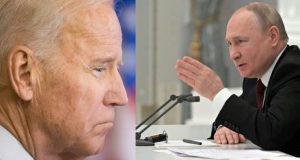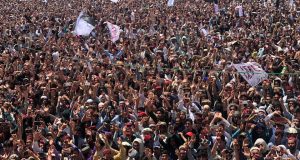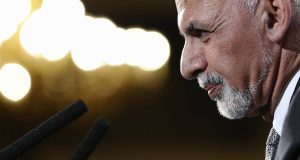Managing Director Baacha Khan Trust Educational Foundation and Pashtun intellectual Dr. Khadim Hussian in an Exclusive Interview with The Pashtun Times
Dr. Khadim Hussain is currently working as Managing Director Baacha Khan Trust Educational Foundation (BKTEF) Peshawar, Pakistan, he has worked as permanent faculty for Linguistics and Communication at Bahria University Islamabad, Pakistan, from 2004 to 2010. He has also taught at the department of Linguistics Qauid-e-Azam University Islamabad for several years.
With a special interest in researching Discourse Construction, Critical Discourse Analysis, and Critical Thinking, Dr. Khadim Hussain has some 30 international research publications and scores of media articles on education, human security, social transformation, culture, linguistics, extremism and terrorism and regional cooperation to his credit besides participation in more than 12 international conferences over the last 15 years.
He has a book “Rethinking Education- Critical Discourse and Society” published in 2012 and another book, ‘The Militant Discourse ‘published in 2013 to his credit. His Urdu novel Paqdandi was published by Narratives Islamabad in 2014. He has been a Co-Researcher for Khyber Pakhtunkhwa in the project titled ‘Mode and Scale of Conflict in Iran, Turkey and Pakistan’ by School of Higher Studies in Social Sciences based in Paris. He has also completed a research project with HEC on the Reading Habits of University Students of Pakistan in 2005. He has completed a project on education reforms with Rand Corporation in 2006.
He has been working as a Resource Person for the workshops organized by Faculty Research Development Program launched by the Higher Education Commission of Pakistan in 2005. Khadim Hussain has been regularly invited as resource person by several national and international organizations to their workshops and conferences on the themes mentioned above. Khadim Hussain has also been engaged in literary creativity, socio-political activism and advocacy for the last 15 years on the issues mentioned above. Being a columnist and political commentator with THE PASHTUN TIMES, he is regularly writing on the issues of militancy, social development and religious extremism in FATA and Pakhtunkhwa. The Pashtun Times’ Editor, Aurangzeb Zalmay, met with Dr. Khadim Hussain for an exclusive interview on his political discourse for Pashtun nation, his efforts for promoting education and Khudai Khidmatgari, peace and nonviolence, his views on the religious extremism inside Pashtun’s society.
The Excerpts below give us an insight into the interesting talk that followed:
Please how you will introduce Pashtuns to our international readers?
As a socio-cultural and socioeconomic unit, the Pashtuns alternatively called Afghans have historically inhabited between the River Indus and the River Amu (Oxus) over the past several hundred years. This region has been under the rule of Cyrus of Iran in the 6th Century BC, going through the Greek, Arayans, Kushans, White Huns and Afghans, to the British Empire in the 19th century A.D. The Pashtuns contributed to the development of Gandhara civilization a great deal. Social organization of the Pashtuns has been greatly influenced by a code called Pakhtunwali/Pashtunwali. The Pashto/Pakhto language of the Pashtuns belongs to the Indo-Iranian branch of languages. Like all other cultural codes, Pashtunwali is also open to diverse interpretations and evolution in the wake of emerging political and economic conditions.
Ghani Khan –a great Pashto poet of 20th century has said in his book that Pathan is not merely a race but, in fact, a state of mind, what do you think?
By a state of mind, Ghani Khan perhaps meant a particular worldview manifested in a particular way of life. Ghani Khan in his book The Pathans (the style of the book borders on allegorical satire) has given numerous examples to illustrate this point. As a cultural unit, the Pashtuns’ worldview has been demonstrated through poetry, music, folklore and values. The salient features of this worldview include collective social organization, unique way of conflict resolution and distinguished customs.
⦁ What is Bacha Khan Education Foundation? Please, also, tell us the role of BKE Foundation in the educational process of Pashtun’s nation? Does it really educate Pashtuns with a modern education for a better future?
The Peshawar-based Baacha Khan Trust (BKT) supports the construction of schools, colleges, hospitals, mosques, orphanages, playgrounds, and other institutions to benefit the community. It promotes peace, human rights, inter-faith harmony and socio-economic uplift of the society through educational programs, youth empowerment and culture revival in Khyber Pakhtunkhwa and FATA.
Read more:
http://thepashtuntimes.com/violence-cannot-be-fought-with-violence-but-non-violence-and-peace-decided-in-the-principals-meeting-of-all-bacha-khan-schools/
⦁ If we see in Pashtun’s society, Madrassah education is at full swing. These Madrassah are usually funded by the Arab’s world. While among the intellectual Pashtuns, each Mullah is considered as the ambassador of Arab imperialism. In such circumstance, how could you see the future of the Pashtun’s kids? How Pashtuns can get rid of religious clutches as in vogue in Pashtun’s society by an Islamic Mullah?
I think religion is a part of Pashtun culture as is the case with all other cultures of the world. Various states and empires have constructed a narrative of Pashtunwali that has exaggerated religious identity more than cultural and national identity for strategic purposes. The powers have used education system, media, share in resources, carrot and stick for the purpose. Petro-dollars have also played substantial role in this process. I think the civil society and political leadership of the Pashtuns have to deconstruct the narrative, connect with their history and connect with modern civilization through education, media and research. I see this process happening, albeit slow.
⦁ Bacha Khan was a great social reformer among the Pashtuns and across the Indus River but he is often confused as a political figure. Is it not a dilemma to criticize him and relate him with the present political conditions happening around the Pashtun’s nation?
This is unfortunate but this is true that aspects of non-violent substantial reform movement by Baacha are mostly overlooked by vested interests for political expediency. Baacha Khan and his movement re-interpreted Pashtunwali, devised framework for economic development of the Pashtuns, initiated campaign for modern education, promoted Pashto language and literature and worked for the development of a culture of dialogue. All this has been conveniently ignored by states of the region for real politics.
Read more:
http://thepashtuntimes.com/bacha-khan-waging-non-violence/
⦁ In your opinion, what success Bacha Khan got and what mistakes he committed in his life, please elaborate?
One of the great achievements of Baacha Khan was transforming Pashtun society to political organization and urban values of modern civilization. Perhaps, putting all weight into the political maneuvering of All India National Congress during the pre-partition era of the Indian Sub-Continent has remained to be considered, even by him, as one of the limitations.
Bacha Khan with M. K. Gandhi
Read more
http://thepashtuntimes.com/khudai-khidmatgaari-resurrects-in-pakhtunkhwa/
⦁ Pashtuns are at war since last 35 years and the future is still uncertain. What do you think, why it is so? Is it lack of unity or the lack of leadership among the Pashtuns?
To be accurate, the Pashtuns are not at war but war has been thrust on the Pashtuns not only over the past 35 years but much before that. The present war is protracted, horrific and visible. This war has been more substantial as it is robbing the Pashtuns of their culture and values. The Pashtun society has been cut limb by limb during this war. It has left hundreds and thousands of the Pashtuns murdered. This war has also cut off social and political leadership of the Pashtuns and created leadership vacuum at grass roots level.
Soul searching is much needed by intelligentsia, academia, civil society organizations and political parties of the Pashtuns to see what went wrong where. Most importantly, regional and international strategic proxy wars have to come to end if the Pashtuns are allowed to live a normal life.
⦁ What do you think about the terrorism in the Pashtun belt? Is it imposed on Pashtuns or it is their own war?
A reasonable amount of literature has been produced over the last several years to understand the enigma of purported religious militancy in Pakistan in general and in Khyber Pakhtunkhwa and the Federally Administered Tribal Areas (FATA) in particular. There are a few problems in the literature produced on religious militancy in Pakistan. Firstly, most of the literature produced over all these years is either substantially generic or unduly specific. Several authors, especially those toeing the line of states establishments, have generically attributed religious militancy to poverty, lack of education, lack of good governance, lack of access to justice system and culture specificity of a particular ethnic group. We need dispel the perception that religious militancy in Pakistan, especially in the Pashtun belt, is because of the above reasons, though these factors may trigger potential religious militancy to active militancy.
Secondly, the literature so far produced evades an understanding of the complexity of the issue. Most of the literature oversimplifies the complexity.
Thirdly, most of the literature presents a particular ideological, political and strategic perspective of particular states in the region and beyond.
The middle class professionals, intelligentsia, media and academics of Europe, the United States, Punjab and the Pashtun Diaspora have started realizing that by buying the theoretical construct that the Pashtun’s culture, society and history are replete with aggression, hardliner Islamism and religious fundamentalism need to be revisited.
Several authors have identified relationship of the present crisis with the decade of 1980s. The US war against the Soviet Union precipitated the potential of religious radicalism in the already volatile region of Central and South Asia – from the River Oxus to the River Indus. The Inter-Services Intelligence (ISI) maneuverings, the Jamaat-i-Islami’s ideological and organizational support, the Saudi petrodollars for establishing hardliner madrassas and the Pakistani military quest for a ‘strategic depth’ in Afghanistan are believed to have led to explosion of the ever present simmering tensions in the Pashtun belt.
⦁ What do you think about the role of Pukhtunwali among the Pashtuns?
Pashtuwali. The dynamic code has incorporated almost every step of civilizational march of humanity in the last several decades. Poetry, art, literature, architecture, music and dance have been inseparable parts of the code that could be retraced over the last several centuries. The dynamic aspect of the code is usually ignored when it is brought under discussion by the academics and media around the globe. On the other hand, the Pashtun society despite having passed through numerous tumultuous experiences has not been able to build on the indigenous values and move forward towards a modern worldview. Both the constructs, the one by the colonial powers and the other by the indigenous people, need to be revisited in the context of the present crisis.
⦁ A very controversial literature is found in Pakistan to propagate the extremism, Jihad etc, what do you think about it.
It is evident from reading a good deal of extremist literature and after listening to their lectures, talks and speeches in Pakistan that constituents of extremist discourse are intricately woven around the central premise of a homogenized world view. The discourse presents a world where every object is identical with every other object. It is a world where all living species have the same brain structure, speaking the same language, thinking the same way, having similar social organization and having similar cultural fabric. Hence, it is important for them to eliminate indigenous socio-cultural fabric everywhere in the world on the one hand while on the other hand the militant discourse tries to push back history through the judicious use of the concept of Khilafat. Both indigenous wisdom and modern human civilization must be the first victim.
The militant discourse uses Aristotelian deductive logic in which language is manipulated to sound esoteric. Figurative expression is usually employed to deny factuality of existence. Through the use of this logic, the discourse has brought about shift in religious authority, e.g., ‘Jihad’ has been decreed to be equal to Qital, and it has been propagated as the only way left for struggle, and finally ‘Jihad’ has been sanctioned as a private enterprise. The concept of Khilafat is nested in the concept of Jihad and the concept of Jihad is nested in the concept of Shahadat. This triangular construct is coupled with ‘authorization’ to make it more lethal in waging a war against the whole world. It is not surprising that religious militant organizations in Pakistan and elsewhere can employ effective techniques to create ‘human bombs’ in the shape of suicide bombers.
⦁ But in the schools also Jihad had been promoted by a special school of thoughts , what do you think?
It is interesting to note that during the late seventies and early eighties most of the public schools in the Pashtun belt were administered by the bulk of the Jamaat-i-Islami ideologues who turned the schools’ environment as well as classrooms into a tool to inculcate the tunnel vision of Jihad. The walls of the dark classrooms contained, and mostly still contain, writings that would exhort the students in the formative years of their life to wage Jihad against the infidels. Tanzeem-i-Asatiza Pakistan, a Jamaat-i-Islami affiliated association of teachers, and Jaish-i-Muhammad had substantial influence in the public schools across the Pashtun belt. Irrational thinking, non-scientific attitude and superstitions were inculcated unabated over the last three decades in elementary and secondary schools across the Pashtun belt. Any expression of art, culture, music and dance were strictly banned in these schools. This ultimately created the type of mental framework that we see in people affiliated to different Jihadist and militant organizations.
⦁ It is said that some Foreign countries have also been fueling the various Jihadist ideologies in the Pkhtun society? is it true?
The Salafi jihadist ideology could have easily made inroads into the Pashtun belt in the form of several religious militant groups considering the erosion of Pashtun social structure due mainly to the developments in the region in the nineteen eighties to fight communism. The natural evolution of the society in the region was blocked due to the intervention of the external forces. Thus the planted groups, most of them Salafi jhadists, made serious efforts to present an alternative discourse, primarily with the help of the secret services of Pakistan, the US, Iran and India, to the one indigenous to socio-cultural groups present in the region. In the absence of socialization through the indigenous socio-cultural groups, the youth might have easily been lured to the religious militant organizations, and so more and more young men and women started identifying themselves with the Salafi (Wahabi) jihadist ideology.
To make it short, all the local, state level, regional and international geo-strategic wars on the one hand and factors of war economy, political Islam and ideological indoctrination on the other hand went into making the complex web of extremist violence in the Pashtun belt.
⦁ What sort of discrimination with Pashtuns and Balochs do you see in Pakistan?
Though the nature, structure and aspects of discrimination and marginalization of the Pashtuns and the Baloch in Pakistan are diverse yet we can observe this marginalization on three levels in a concrete level.
– On the political level, we see centralization of power and resources by the Pakistani establishment. Though some of the political marginalization has been ameliorated with the some devolution after the 18th Constitutional Amendment in 2010, there are still substantial aspects of marginalization faced by the Pashtuns and the Baloch on daily basis. The right to ownership of resources is an issue that is yet to be resolved. The Pashtuns in Federally Administered Tribal Areas (FATA) have yet to live under the draconian law of Frontier Crimes Regulation (FCR). Various parts of the Pashtun belt are forced to live under different administrative structures and forcibly isolated from one another on one or other pretext.
–On a socio-cultural level, the Pashtuns and the Baloch are still constructed with a reductionist paradigm. They are constructed to be sub-humans by the mainstream Pakistan. They have remained victims of the worst kind of stereotyping by the mainstream Pakistani media and intelligentsia.
– On a political and economic level , the Pashtuns have been largely unrecognised politically, denied due right and ownership of resources economically and constructed as sons of a lesser god culturally.
⦁ What is your take on the dynamics of Awami National Party (ANP) and Pakhtunkhwa Milli Awami Party (PMAP)?
-The Awami National Party (ANP) is a predecessor of the Khudai Khidmataggar movement. Formed in 1986, ANP like its predecessors, the NAP (National Awami Party) and the NDP (National Democratic Party), looks upon politics primarily as a public service, particularly to the poor and the disadvantaged. Hence the Party is dedicated to the promotion of democracy and freedom, the eradication of poverty, the protection of human rights, the combating of extremism in all its forms and the creation of equal opportunities for all citizens. It firmly believes in peace and non-violence as the best way to resolve all issues.
ANP largely draws its support of the north western parts of the Pashtun belts, mainly from the five districts of Peshawar valley.

-The PMAP differs with ANP only in its demand to have a renewed social contract with the state through the election of a constituent assembly. The PMAP largely draws its support from the southern parts of the Pashtun belt.
Both the parties have almost the same stand on various political, social, economic and cultural challenges faced by the Pashtuns but with a different approach mainly due to the demography of their representation. As northern and southern parts of the Pashtuns have been forced to live in different federating units for a long time, some of the cultural values have become divergent. That is what leads to the differences of the two parties in the approaches to politics in Pakistan.
Interviewed by Aurangzeb Zalmay, Editor and founder of THE PASHTUN TIMES.
He can be reached at
zalmaygcu@gmail.com or editor@thepashtuntimes.com
ALL RIGHTS RESERVED WITH THE PASHTUN TIMES
 Pashtun Times Latest News
Pashtun Times Latest News



![-abdul-ghaffar-khan-Gandi]](https://thepashtuntimes.com/wp-content/uploads/2016/03/abdul-ghaffar-khan-Gandi.jpg)






